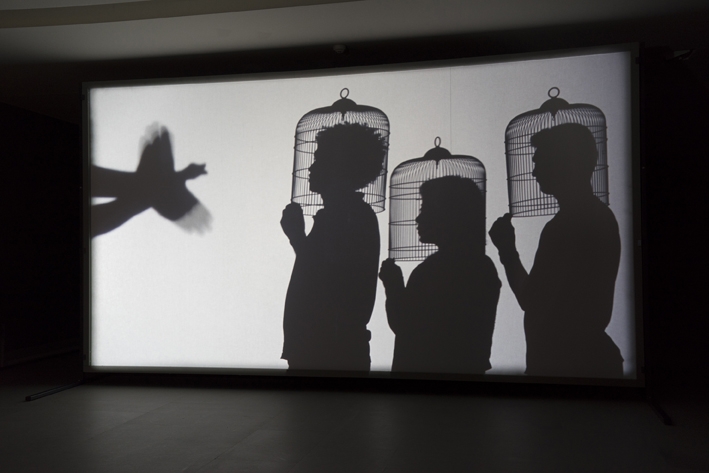Rimbaud’s statement ‘I am an other’ rings in the back of the head throughout Shadow Play, a solo exhibition by Venezuelan artist, Javier Téllez. Composed of seven spaces in which six of Téllez’s films from the last ten years play looped, the exhibition also develops thematically as the viewer moves from space to space. Cinematic and symbolic elements (the use of written text on blackboards or a person pulling an object resting on a camera dolly round in a circle), are reprised from earlier works. The first two films the audience encounter are the two new works commissioned for this presentation. All of the films are made in collaboration with members of marginalised groups – refugees, mental health patients, those with physical disabilities, the incarcerated – and who are both the actors in and co-producers of the stories. The exhibition’s title alludes to the metaphorical shadows to which these marginalised populations tend to be exiled.
Bourbaki Panorama (2014) uses a nineteenth-century war Panorama with dioramic elements – figures and objects, from Luzern as the backdrop for a metaphoric and poetic exploration of migration and displacement. Several refugees to Switzerland are seen in the foreground walking slowly around the circular space, while a black female pulls a dolly on which Giacometti’s sculpture, The Hand (1947) rests, a comment on the global reality of migration in relation to Switzerland’s own borders and the creative power of the human hand, themes which reappear in the second film Shadow Play (2014) where, as in the shadow plays of eighteenth-century France, the action is played out in silhouettes. Here another recurring element in Téllez’s work appears – the blackboard that announces each character with their name and place of origin, eliminating their anonymity and bringing us closer to their personal narratives. The blackboard also functions to disrupt the flow of the film, giving a pause for reflection. Both of these works are shot on 16mm film and played on antique reel projectors, taking cinema back to its origins and echoing the idea of the hand in artistic production.
The third room is a study centre of sorts, displaying essential texts from which Téllez drew his inspiration, from Antonin Artaud to Diderot and others in between. This also pauses the visitors as they move through the spaces, performing the same function within the exhibition as the blackboards do in the individual films.
From here we encounter four of Téllez’s earlier films, including Caligari and the Sleepwalker (2008), a reinterpretation of 1920 silent horror ‘The Cabinet of Dr. Caligari’, made in collaboration with mental health patients, and where the blackboard is used to show the characters’ words. The next film, Durer’s Rhinoceros (2010) was made on location at Miguel Bombarda Hospital in Lisbon, with the patients of the day clinic there. The motif of a person pulling a load is also seen here, as one of the patients pulls a taxidermied rhino around in a similar fashion, an allusion to Durer’s engraving, and also to the architecture of control of the panopticon-shaped hospital. The next room shows Letter on the Blind for the Use of those Who See (2007), made with six blind individuals who try to understand, through touch, the anatomy of an elephant. As in Durer’s Rhinoceros, here the blackboards are replaced by voiceovers in which the patients reveal autobiographical fragments. The final film, La Conquista De México (2012), inspired by Artaud’s 1934 text ‘The Conquest of Mexico’, and commissioned for Documenta 13, was shot in a Mexico psychiatric hospital, once again made with the patients there.
As an exhibition Shadow Play questions our perception of who is and who isn’t peripheral. It attempts to reveal the mechanisms of control in society, the absurd boundaries we set between reality and fiction, sane and insane, the self and the other. And it provides a bridge to all those others, allowing us to put Rimbaud’s famous statement in to practice.
Online exclusive published 18 December 2014
